2015 FIAT GRANDE PUNTO ACTUAL handbrake
[x] Cancel search: handbrakePage 123 of 216
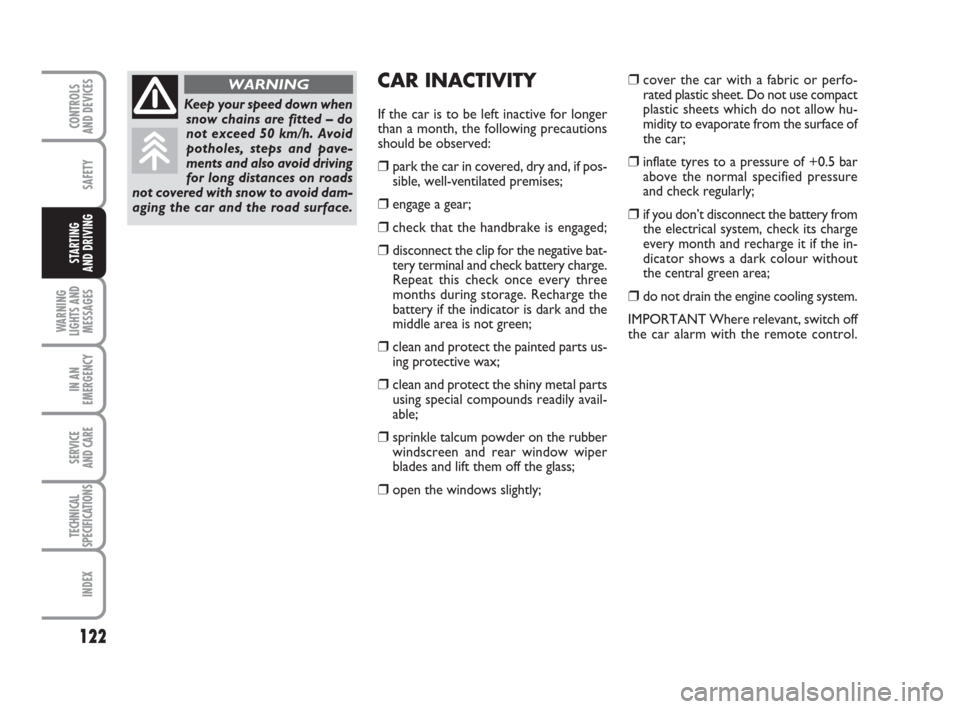
122
SAFETY
WARNING
LIGHTS AND
MESSAGES
IN AN
EMERGENCY
SERVICE
AND CARE
TECHNICAL
SPECIFICATIONS
INDEX
CONTROLS
AND DEVICES
STARTING
AND DRIVING
CAR INACTIVITY
If the car is to be left inactive for longer
than a month, the following precautions
should be observed:
❒park the car in covered, dry and, if pos-
sible, well-ventilated premises;
❒engage a gear;
❒check that the handbrake is engaged;
❒disconnect the clip for the negative bat-
tery terminal and check battery charge.
Repeat this check once every three
months during storage. Recharge the
battery if the indicator is dark and the
middle area is not green;
❒clean and protect the painted parts us-
ing protective wax;
❒clean and protect the shiny metal parts
using special compounds readily avail-
able;
❒sprinkle talcum powder on the rubber
windscreen and rear window wiper
blades and lift them off the glass;
❒open the windows slightly;
❒cover the car with a fabric or perfo-
rated plastic sheet. Do not use compact
plastic sheets which do not allow hu-
midity to evaporate from the surface of
the car;
❒inflate tyres to a pressure of +0.5 bar
above the normal specified pressure
and check regularly;
❒if you don’t disconnect the battery from
the electrical system, check its charge
every month and recharge it if the in-
dicator shows a dark colour without
the central green area;
❒do not drain the engine cooling system.
IMPORTANT Where relevant, switch off
the car alarm with the remote control.
Keep your speed down when
snow chains are fitted – do
not exceed 50 km/h. Avoid
potholes, steps and pave-
ments and also avoid driving
for long distances on roads
not covered with snow to avoid dam-
aging the car and the road surface.
WARNING
111-122 ACTUAL 1ed EN 20-07-2010 16:10 Pagina 122
Page 124 of 216
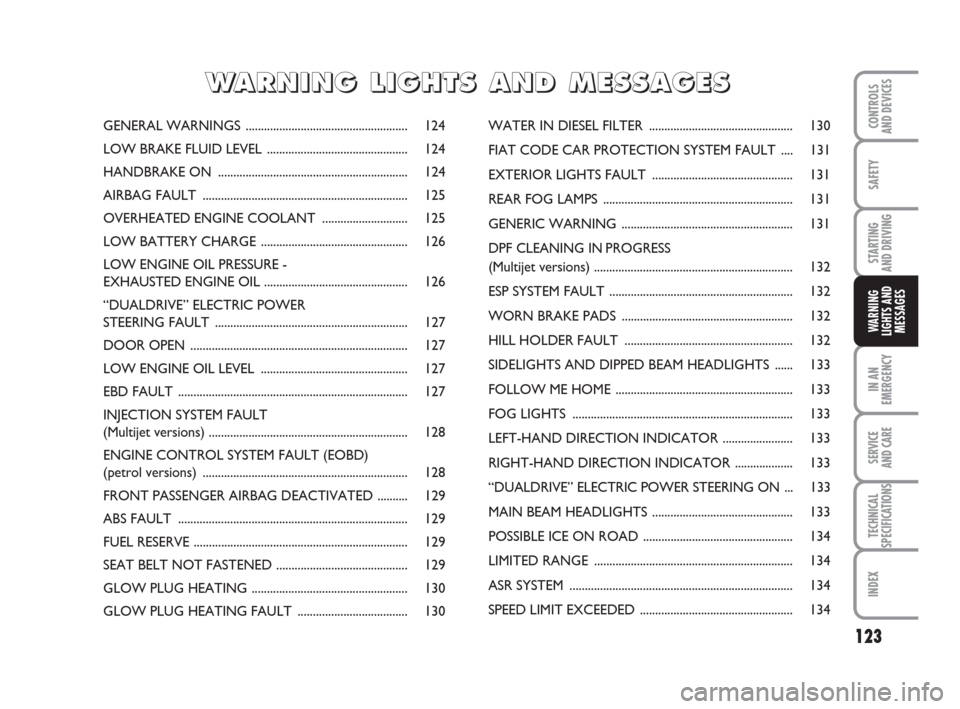
123
SAFETY
STARTING
AND DRIVING
IN AN
EMERGENCY
SERVICE
AND CARE
TECHNICAL
SPECIFICATIONS
INDEX
CONTROLS
AND DEVICES
WARNING
LIGHTS AND
MESSAGES
GENERAL WARNINGS ..................................................... 124
LOW BRAKE FLUID LEVEL .............................................. 124
HANDBRAKE ON .............................................................. 124
AIRBAG FAULT ................................................................... 125
OVERHEATED ENGINE COOLANT ............................ 125
LOW BATTERY CHARGE ................................................ 126
LOW ENGINE OIL PRESSURE -
EXHAUSTED ENGINE OIL ............................................... 126
“DUALDRIVE” ELECTRIC POWER
STEERING FAULT ............................................................... 127
DOOR OPEN ....................................................................... 127
LOW ENGINE OIL LEVEL ................................................ 127
EBD FAULT ........................................................................... 127
INJECTION SYSTEM FAULT
(Multijet versions) ................................................................. 128
ENGINE CONTROL SYSTEM FAULT (EOBD)
(petrol versions) ................................................................... 128
FRONT PASSENGER AIRBAG DEACTIVATED .......... 129
ABS FAULT ........................................................................... 129
FUEL RESERVE ...................................................................... 129
SEAT BELT NOT FASTENED ........................................... 129
GLOW PLUG HEATING ................................................... 130
GLOW PLUG HEATING FAULT .................................... 130WATER IN DIESEL FILTER ............................................... 130
FIAT CODE CAR PROTECTION SYSTEM FAULT .... 131
EXTERIOR LIGHTS FAULT .............................................. 131
REAR FOG LAMPS .............................................................. 131
GENERIC WARNING ........................................................ 131
DPF CLEANING IN PROGRESS
(Multijet versions) ................................................................. 132
ESP SYSTEM FAULT ............................................................ 132
WORN BRAKE PADS ........................................................ 132
HILL HOLDER FAULT ....................................................... 132
SIDELIGHTS AND DIPPED BEAM HEADLIGHTS ...... 133
FOLLOW ME HOME .......................................................... 133
FOG LIGHTS ........................................................................ 133
LEFT-HAND DIRECTION INDICATOR ....................... 133
RIGHT-HAND DIRECTION INDICATOR ................... 133
“DUALDRIVE” ELECTRIC POWER STEERING ON ... 133
MAIN BEAM HEADLIGHTS .............................................. 133
POSSIBLE ICE ON ROAD ................................................. 134
LIMITED RANGE ................................................................. 134
ASR SYSTEM ......................................................................... 134
SPEED LIMIT EXCEEDED .................................................. 134
W W
A A
R R
N N
I I
N N
G G
L L
I I
G G
H H
T T
S S
A A
N N
D D
M M
E E
S S
S S
A A
G G
E E
S S
123-134 ACTUAL 1ed EN 31-08-2010 9:23 Pagina 123
Page 125 of 216
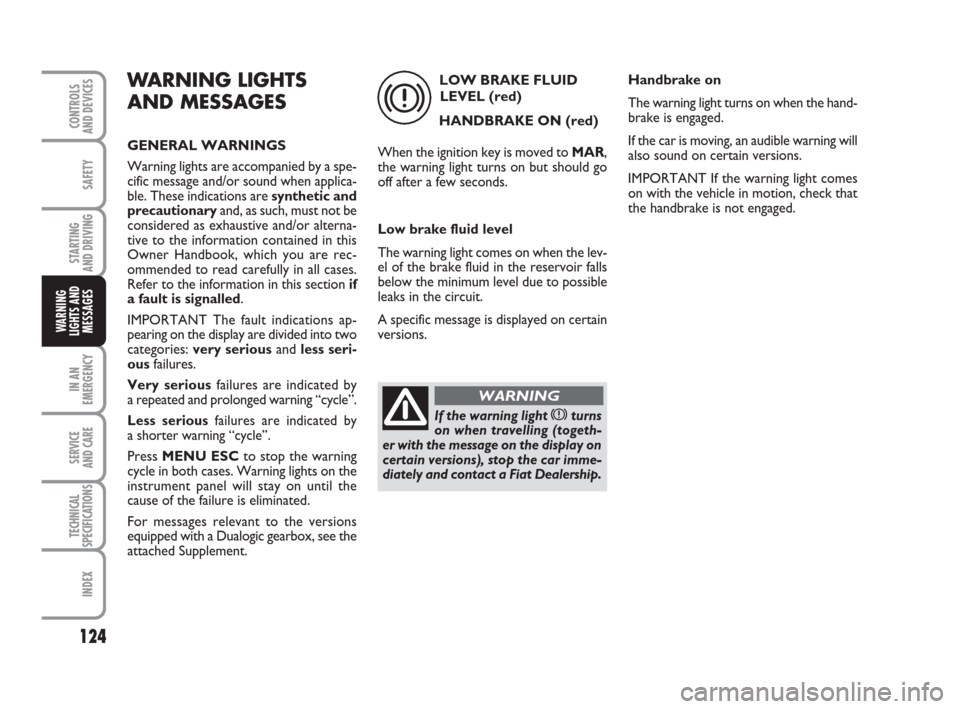
124
SAFETY
STARTING
AND DRIVING
IN AN
EMERGENCY
SERVICE
AND CARE
TECHNICAL
SPECIFICATIONS
INDEX
CONTROLS
AND DEVICES
WARNING
LIGHTS AND
MESSAGES
WARNING LIGHTS
AND MESSAGES
GENERAL WARNINGS
Warning lights are accompanied by a spe-
cific message and/or sound when applica-
ble. These indications are synthetic and
precautionaryand, as such, must not be
considered as exhaustive and/or alterna-
tive to the information contained in this
Owner Handbook, which you are rec-
ommended to read carefully in all cases.
Refer to the information in this sectionif
a fault is signalled.
IMPORTANT The fault indications ap-
pearing on the display are divided into two
categories: very seriousand less seri-
ousfailures.
Very seriousfailures are indicated by
a repeated and prolonged warning “cycle”.
Less seriousfailures are indicated by
a shorter warning “cycle”.
Press MENU ESCto stop the warning
cycle in both cases. Warning lights on the
instrument panel will stay on until the
cause of the failure is eliminated.
For messages relevant to the versions
equipped with a Dualogic gearbox, see the
attached Supplement.LOW BRAKE FLUID
LEVEL (red)
HANDBRAKE ON (red)
When the ignition key is moved to MAR,
the warning light turns on but should go
off after a few seconds.
Low brake fluid level
The warning light comes on when the lev-
el of the brake fluid in the reservoir falls
below the minimum level due to possible
leaks in the circuit.
A specific message is displayed on certain
versions.
x
If the warning light xturns
on when travelling (togeth-
er with the message on the display on
certain versions), stop the car imme-
diately and contact a Fiat Dealership.
WARNING
Handbrake on
The warning light turns on when the hand-
brake is engaged.
If the car is moving, an audible warning will
also sound on certain versions.
IMPORTANT If the warning light comes
on with the vehicle in motion, check that
the handbrake is not engaged.
123-134 ACTUAL 1ed EN 31-08-2010 9:23 Pagina 124
Page 138 of 216
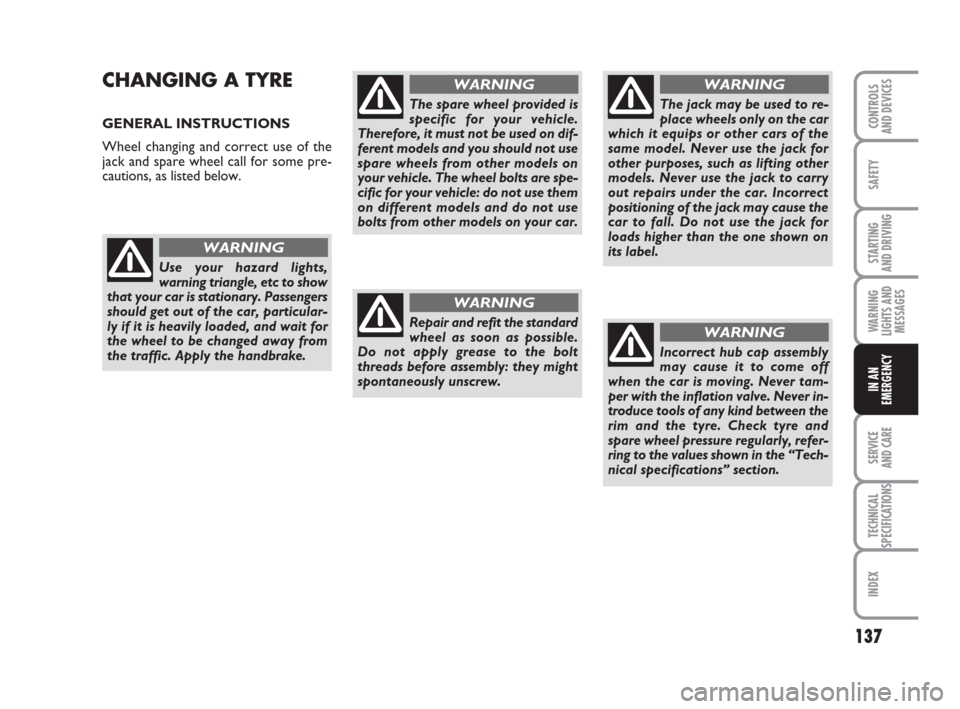
137
SAFETY
STARTING
AND DRIVING
WARNING
LIGHTS AND
MESSAGES
SERVICE
AND CARE
TECHNICAL
SPECIFICATIONS
INDEX
CONTROLS
AND DEVICES
IN AN
EMERGENCY
CHANGING A TYRE
GENERAL INSTRUCTIONS
Wheel changing and correct use of the
jack and spare wheel call for some pre-
cautions, as listed below.
Use your hazard lights,
warning triangle, etc to show
that your car is stationary. Passengers
should get out of the car, particular-
ly if it is heavily loaded, and wait for
the wheel to be changed away from
the traffic. Apply the handbrake.
WARNING
The spare wheel provided is
specific for your vehicle.
Therefore, it must not be used on dif-
ferent models and you should not use
spare wheels from other models on
your vehicle. The wheel bolts are spe-
cific for your vehicle: do not use them
on different models and do not use
bolts from other models on your car.
WARNING
Repair and refit the standard
wheel as soon as possible.
Do not apply grease to the bolt
threads before assembly: they might
spontaneously unscrew.
WARNING
The jack may be used to re-
place wheels only on the car
which it equips or other cars of the
same model. Never use the jack for
other purposes, such as lifting other
models. Never use the jack to carry
out repairs under the car. Incorrect
positioning of the jack may cause the
car to fall. Do not use the jack for
loads higher than the one shown on
its label.
WARNING
Incorrect hub cap assembly
may cause it to come off
when the car is moving. Never tam-
per with the inflation valve. Never in-
troduce tools of any kind between the
rim and the tyre. Check tyre and
spare wheel pressure regularly, refer-
ring to the values shown in the “Tech-
nical specifications” section.
WARNING
135-166 ACTUAL 1ed EN 26-07-2010 16:00 Pagina 137
Page 145 of 216
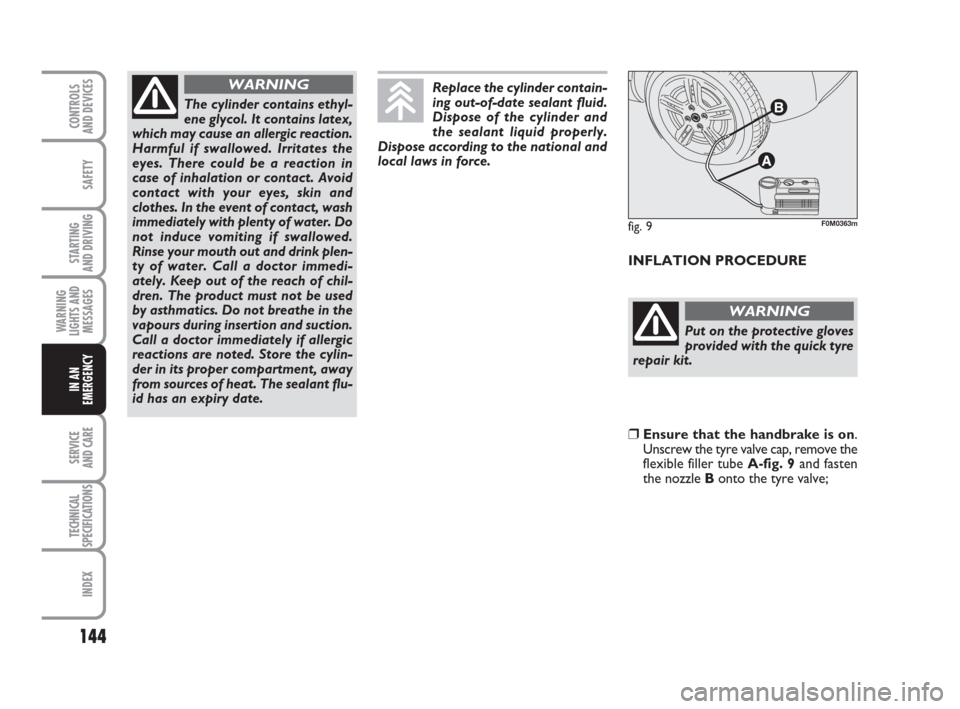
144
SAFETY
STARTING
AND DRIVING
WARNING
LIGHTS AND
MESSAGES
SERVICE
AND CARE
TECHNICAL
SPECIFICATIONS
INDEX
CONTROLS
AND DEVICES
IN AN
EMERGENCY
INFLATION PROCEDURE
The cylinder contains ethyl-
ene glycol. It contains latex,
which may cause an allergic reaction.
Harmful if swallowed. Irritates the
eyes. There could be a reaction in
case of inhalation or contact. Avoid
contact with your eyes, skin and
clothes. In the event of contact, wash
immediately with plenty of water. Do
not induce vomiting if swallowed.
Rinse your mouth out and drink plen-
ty of water. Call a doctor immedi-
ately. Keep out of the reach of chil-
dren. The product must not be used
by asthmatics. Do not breathe in the
vapours during insertion and suction.
Call a doctor immediately if allergic
reactions are noted. Store the cylin-
der in its proper compartment, away
from sources of heat. The sealant flu-
id has an expiry date.
WARNINGReplace the cylinder contain-
ing out-of-date sealant fluid.
Dispose of the cylinder and
the sealant liquid properly.
Dispose according to the national and
local laws in force.
Put on the protective gloves
provided with the quick tyre
repair kit.
WARNING
❒Ensure that the handbrake is on.
Unscrew the tyre valve cap, remove the
flexible filler tube A-fig. 9and fasten
the nozzle Bonto the tyre valve;
fig. 9F0M0363m
135-166 ACTUAL 1ed EN 26-07-2010 16:00 Pagina 144
Page 146 of 216
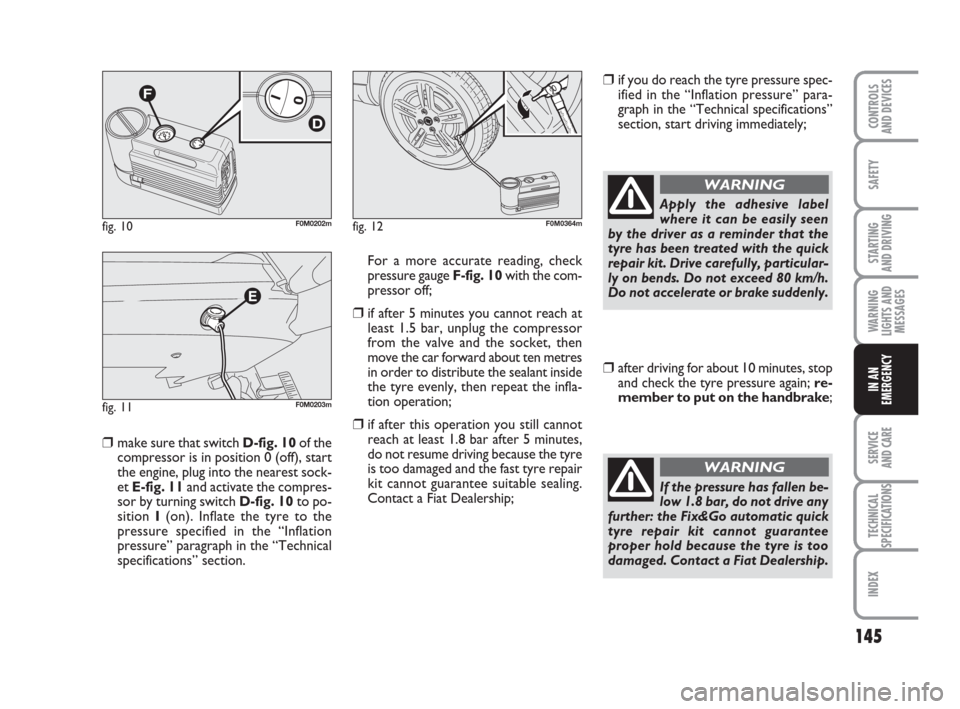
145
SAFETY
STARTING
AND DRIVING
WARNING
LIGHTS AND
MESSAGES
SERVICE
AND CARE
TECHNICAL
SPECIFICATIONS
INDEX
CONTROLS
AND DEVICES
IN AN
EMERGENCY
❒ make sure that switch D-fig. 10of the
compressor is in position 0 (off), start
the engine, plug into the nearest sock-
et E-fig. 11and activate the compres-
sor by turning switch D-fig. 10to po-
sition I(on). Inflate the tyre to the
pressure specified in the “Inflation
pressure” paragraph in the “Technical
specifications” section. For a more accurate reading, check
pressure gauge F-fig. 10with the com-
pressor off;
❒if after 5 minutes you cannot reach at
least 1.5 bar, unplug the compressor
from the valve and the socket, then
move the car forward about ten metres
in order to distribute the sealant inside
the tyre evenly, then repeat the infla-
tion operation;
❒if after this operation you still cannot
reach at least 1.8 bar after 5 minutes,
do not resume driving because the tyre
is too damaged and the fast tyre repair
kit cannot guarantee suitable sealing.
Contact a Fiat Dealership;
❒if you do reach the tyre pressure spec-
ified in the “Inflation pressure” para-
graph in the “Technical specifications”
section, start driving immediately;
fig. 10F0M0202m
fig. 11F0M0203m
fig. 12F0M0364m
Apply the adhesive label
where it can be easily seen
by the driver as a reminder that the
tyre has been treated with the quick
repair kit. Drive carefully, particular-
ly on bends. Do not exceed 80 km/h.
Do not accelerate or brake suddenly.
WARNING
❒after driving for about 10 minutes, stop
and check the tyre pressure again; re-
member to put on the handbrake;
If the pressure has fallen be-
low 1.8 bar, do not drive any
further: the Fix&Go automatic quick
tyre repair kit cannot guarantee
proper hold because the tyre is too
damaged. Contact a Fiat Dealership.
WARNING
135-166 ACTUAL 1ed EN 26-07-2010 16:00 Pagina 145
Page 147 of 216
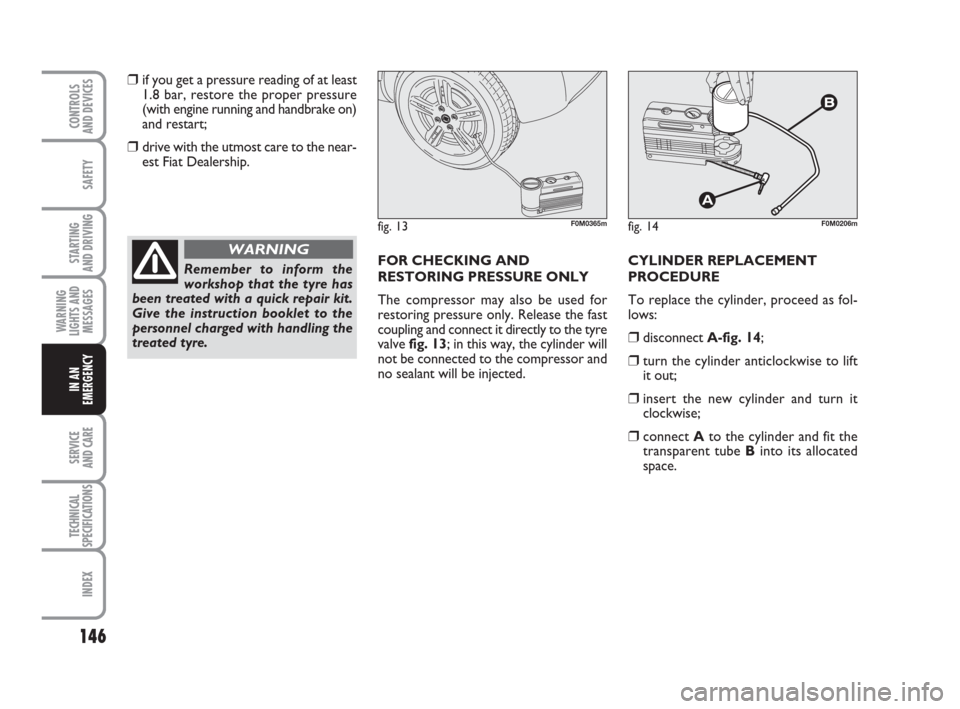
146
SAFETY
STARTING
AND DRIVING
WARNING
LIGHTS AND
MESSAGES
SERVICE
AND CARE
TECHNICAL
SPECIFICATIONS
INDEX
CONTROLS
AND DEVICES
IN AN
EMERGENCY
❒if you get a pressure reading of at least
1.8 bar, restore the proper pressure
(with engine running and handbrake on)
and restart;
❒drive with the utmost care to the near-
est Fiat Dealership.
FOR CHECKING AND
RESTORING PRESSURE ONLY
The compressor may also be used for
restoring pressure only. Release the fast
coupling and connect it directly to the tyre
valve fig. 13; in this way, the cylinder will
not be connected to the compressor and
no sealant will be injected. CYLINDER REPLACEMENT
PROCEDURE
To replace the cylinder, proceed as fol-
lows:
❒disconnect A-fig. 14;
❒turn the cylinder anticlockwise to lift
it out;
❒insert the new cylinder and turn it
clockwise;
❒connect Ato the cylinder and fit the
transparent tube Binto its allocated
space.
Remember to inform the
workshop that the tyre has
been treated with a quick repair kit.
Give the instruction booklet to the
personnel charged with handling the
treated tyre.
WARNING
fig. 13F0M0365mfig. 14F0M0206m
135-166 ACTUAL 1ed EN 26-07-2010 16:00 Pagina 146
Page 170 of 216
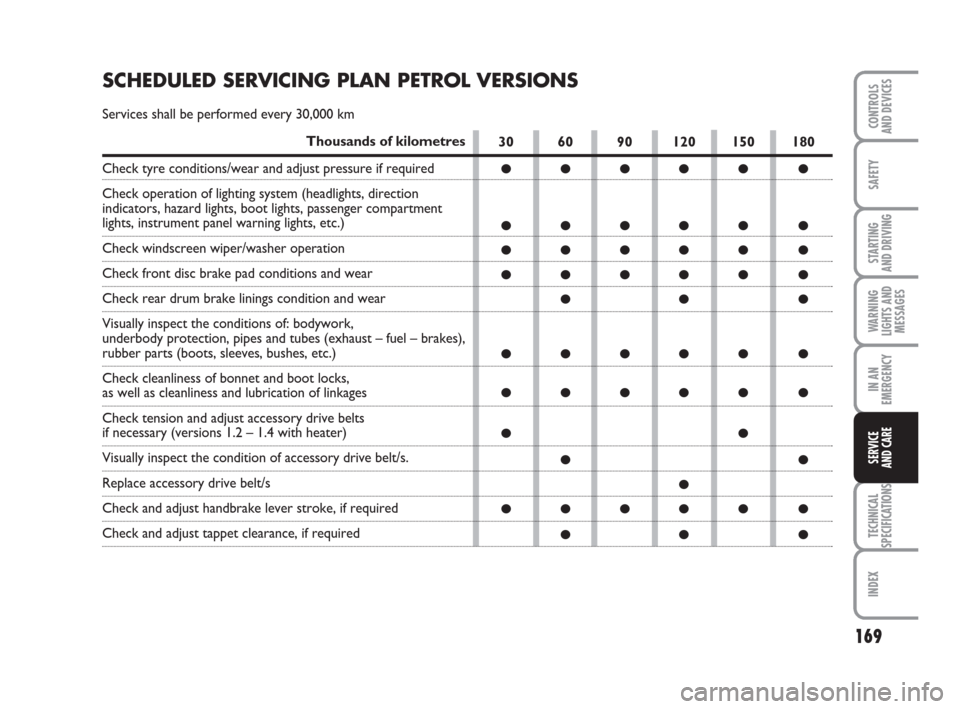
169
SAFETY
STARTING
AND DRIVING
WARNING
LIGHTS AND
MESSAGES
IN AN
EMERGENCY
TECHNICAL
SPECIFICATIONS
INDEX
CONTROLS
AND DEVICES
SERVICE
AND CARE
30 60 90 120 150 180
●●●●● ●
●●●●● ●
●●●●● ●
●●●●● ●
●● ●
●●●●● ●
●●●●● ●
●●
●●
●
●●●●● ●
●● ●
SCHEDULED SERVICING PLAN PETROL VERSIONS
Services shall be performed every 30,000 km
Thousands of kilometres
Check tyre conditions/wear and adjust pressure if required
Check operation of lighting system (headlights, direction
indicators, hazard lights, boot lights, passenger compartment
lights, instrument panel warning lights, etc.)
Check windscreen wiper/washer operation
Check front disc brake pad conditions and wear
Check rear drum brake linings condition and wear
Visually inspect the conditions of: bodywork,
underbody protection, pipes and tubes (exhaust – fuel – brakes),
rubber parts (boots, sleeves, bushes, etc.)
Check cleanliness of bonnet and boot locks,
as well as cleanliness and lubrication of linkages
Check tension and adjust accessory drive belts
if necessary (versions 1.2 – 1.4 with heater)
Visually inspect the condition of accessory drive belt/s.
Replace accessory drive belt/s
Check and adjust handbrake lever stroke, if required
Check and adjust tappet clearance, if required
167-186 ACTUAL 1ed EN 27-07-2010 10:30 Pagina 169